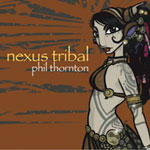| The Musicians
 Professor
Maged Serour (Qanun) Professor
Maged Serour (Qanun)
Well known in the Middle East and Internationally as one of the top players
of his instrument he is in constant demand, recording with the best artists
from the region and leading the most acclaimed ensembles and orchestras
as well as recording his first solo album 'Qanun el Tarab'.
The qanun (ka-noon) is a plucked box zither or psaltery
of the Middle East, North Africa and parts of Asia. In its final design
and form the instrument was invented in the Abbasy period in the history
of the middle east by the legendary musician and instrument maker Al Faraby
(950 AD) the instrument has its roots extending back to the Pharaohs’
times when it was called Sabkh, also Assyrian roots where it was called
the Nozha. A similar instrument was widely used during the time of the
Greek Empire and was called the monochord. The modern qanun is equipped
with small brass levers on each string allowing 1/4 tone intervals to
be played.
|
 Shebl
Abdalla (Magrouna/Mizmar) Shebl
Abdalla (Magrouna/Mizmar)
Shebl leads the well known Gypsies of the Nile group. Their debut album
Rahhal has been well received all over the world. They are in much demand
throughout Egypt playing at weddings, festivals and religious celebrations.
The magrouna is a twin piped reed instrument of ancient
origin. The two tubes are of equal length tied in parallel, so that the
corresponding holes can be closed simultaneously allowing both pipes to
play in unison creating a rich ‘chorus’ like tone. The Magrouna
is played exclusively by men who use a circular breathing technique to
produce an uninterrupted sound. The mizmar is a double reed woodwind instrument
similar in shape to the traditional conical Oboe. Another instrument of
ancient origin, which is also known as the Zurna in Iran, Turkey and amongst
the Kurdish people. Often used at weddings and for traditional Belly dance
throughout the Middle East.
|
 Mohamed
Naiem (Nay/Kawala) Mohamed
Naiem (Nay/Kawala)
Mohamed has a rare talent in playing both types of flute with such soul-captivating
spirituality. Since moving to Cairo from his hometown Port-Said he has
gained an enviable reputation amongst his fellow musicians and audiences
alike. His debut album Master of the Arabian Flute has just been released
worldwide.
The most common type of Arabic reed flute, the nay produces
a mellow breathy sound. It can be anywhere between 35cm to 80cm long but
always with the distinctive feature of the reed having 9 joints. The sound
is produced by blowing across the open end at an angle. A nay player will
normally play to a scale called ‘rast’ which has quarter tones
on the third and seventh notes. The kawala is another type of Arabic flute
with a more rounded sound, produced in part by having a wider bore. This
instrument has a most haunting sound usually associated with religious
music. The kawala is generally considered to be harder to play than the
nay with its different fingering and sound. For this reason it is quite
rare for a player to become a master of both instruments.
|
 Reda
Sobhy (Rebaba) Reda
Sobhy (Rebaba)
Reda is another member of the highly acclaimed Gypsies of the Nile touring
group.
The rebaba is a very early form of Violin still in use today.
It has 2 strings and is played in the upright position with a bow.
|
 Said
Kamal (Violin) Said
Kamal (Violin)
One of Cairo’s top session players, Said is also much in demand
as an arranger and since meeting Hossam in 2001 has featured on all his
recordings.
|
 Osama
El Hendy (Accordion) Osama
El Hendy (Accordion)
One of Hossam’s dearest friends and musical collaborators Osama
is fast becoming one of Cairo’s top record producers with his name
constantly appearing in the Egyptian charts.
The egyptian accordion is a standard accordion (usually
Italian or German) that has been modified by filing down some of the reeds
to create the quartertone scales used in
Egyptian music.
|
 Hazem
Shaheen (Aud) Hazem
Shaheen (Aud)
Hazem was born in Alexandria where he studied at the Arab Institute of
Music graduating with the highest honours. He is currently the leading
teacher in Cairo’s highly respected ‘House of Aud’ music
school and has been voted best Aud player in the Middle East several years
running. His playing is well known throughout the region through his live
and recorded performances.
The aud (oud, ud ) is the direct ancestor of the lute, the
main difference being a lack of frets. It has 11 strings arranged as 5
pairs with a single bass
string. In ancient Egypt it was known as the Nefer and is regarded to
this day as the Sultan or ‘King’ of musical instruments.
|
 Grant
Young (Fretless bass) Grant
Young (Fretless bass)
Grant has been adding his distinctive style to Phil’s music since
they first met in the early 1980’s as well as performing live with
many bands playing everything from soul to punk rock including the Teenbeats
(Number 1 in Canadian charts)
|

Click here for more details of
ethnic instruments used on my recordings
|
































